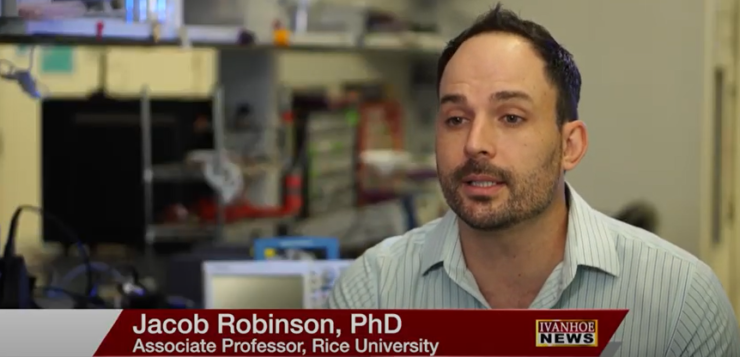Jacob Robinson, PhD, Associate Professor of Electrical and Computer Engineering, Rice University, talks about new improved less invasive implants.
Tell me about this work you are doing. What is it that you and your colleagues are looking at?
ROBINSON: What we’re looking at is ways to create very tiny electronic devices to help treat things like pain, mood disorders, look at neuro-regeneration, basically thinking about ways we can make medicines that work using electronics.
And why is that so important?
ROBINSON: Broadly speaking, the importance of trying to use electronic devices as medicine is that these devices can change quickly throughout the day in ways that taking a pill can’t. It can be tailored to the individual needs of the patient in consultation with their doctor, maybe even remotely. You can kind of retune the therapies that you’re receiving because it can be updated like a phone can be updated.
The most recent news about it is that you’re able to control multiple implants with a single transmitter. Can you talk about that a little bit?
ROBINSON: Yeah, absolutely. One of the challenges of thinking about electronic therapies is that we might want to have effects in different parts of the body at the same time. Your body is controlled by your network of nerves that kind of go throughout your body. From electronics sense, you can think of this as basically your body is hardwired. Now, if we want to come in and we want to tune how those signals are propagating, we want to come in maybe at multiple different spots to kind of adjust the electrical signals that are kind of controlling the organs in your body. Now, we don’t necessarily want to put in a big device that connects to all these places and rewires that particular network. If you’ve ever done a renovation in your house, you must rip apart your walls if I want to run cables around. But what we want is a wireless network that can tap into the natural network of the body, and to do that we want to make these miniature bio-electronic devices that can communicate wirelessly with the base station that’s outside the body.
What is your particular role?
ROBINSON: So, what we’ve been working on in my lab is thinking about how we can communicate with devices as they become very tiny, and they’re put inside the body. The challenge is that our bodies are mostly salt water and sending information through salt water is very challenging. If you think about movies, you know, from World War 2, the submarine has to go to the surface to send signals, right? That’s because we can’t send those signals through salt water very easily. So, we must solve that same problem when we’re thinking about sending data and power to devices that are deep inside the body. The way that we approach solving that is by using a special material that converts magnetic fields, which can go through the body, into electric fields that power our devices. So, the work in my lab is to think about what are the materials that’ll will help us convert this magnetic field into electric energy that will drive our implants?
Mac was telling me that you guys work with, like, hydras?
ROBINSON: Yes.
Can you talk a little bit about that and what exactly are they?
ROBINSON: I can connect it. So, in my lab, we also are testing these devices in cells that we grow in the lab and in tiny organisms that help us see when our devices are active. One ne of the ways that we do this if you have a tiny freshwater jellyfish called hydra, and these animals will contract if there’s electrical stimulation. So, we can tell when our devices are working, when they’re activating biological tissue by using these tiny little organisms as a way for us to measure the effect of our electronic device.
What kind of devices can this be applied to?
ROBINSON: There’s a lot of therapies that we think these devices can be applied for. We can think about cardiac pacing where we might have a very tiny implant that can be positioned at different parts in the cardiac chambers. We’ve been also looking at pain therapies, how we might be able to deliver devices through minimally invasive procedures to parts of the spinal column that are typically stimulated to help alleviate chronic pain. So, the other things that we’re looking at for this technology is neurodegeneration. We can put these tiny implants across a severed nerve and apply electrical stimulation that’ll help that nerve reform.
What kind of advantages can this have for patients down the line?
ROBINSON: So, I think the major advantages of this technology is that, as we make these bio-electronic devices smaller and smaller, the procedures become less risky for the patients, the recovery times are shorter. When you think about how you might treat diseases of the future, maybe a quick procedure, 10-minute outpatient procedure with your clinician could help put one of these bioelectronic devices in your body and then you would not have to take pharmaceutical medication maybe for that disease ever again.
For example, a pacemaker, would it ever let’s say decrease the size of the pacemaker, making it smaller, allowing it to be a smaller device?
ROBINSON: I think the way devices work now is that their base station is connected to the stimulation point by electronic wire. We can think about things like pacemakers as not just being smaller, per say, but able to reach stimulation points that would be very difficult to connect with a hard wire. So, it’s not just that these therapies might be less invasive, but they might be more effective because we can reach better targets.
This might be a difficult question to answer, but how far down the line do you think you could see this in the clinical setting?
ROBINSON: That’s a great question. It’s difficult to anticipate when we’re going to see these types of technologies in the clinical setting. We’re on the path now to validate some of these approaches in large animal models as the first step to getting FDA approval to begin human trials. I expect that we would be able to start human trials probably in a couple of years for some of the therapies that we propose.
Are you thinking like two, five years?
ROBINSON: I think within a couple of years we’ll be able to begin human trials for some of the neural stimulation therapies that we’re planning.
Anything that I didn’t ask you that you feel like people should know?
ROBINSON: People get freaked out when they think about having wireless electronic devices put inside their body. So, one of the things that we’re very considerate of as we begin to develop these technologies is how can we make them safe and secure so that only you and your clinician have control of your device? One of the things that we really like about this approach is that the communication between our implant and our base station only exists over a couple of centimeters, so you must be extremely close to talk to your device. So, it’s not like your device is connected to the internet. So, we have various tight controls over privacy and security for these types of devices, which we think is critical for developing electronic therapies for health.
There are all these shows that show that people like to watch, crime tech shows, that say that criminals can control pacemakers. Is that really a thing?
ROBINSON: I think security for biomedical devices is incredibly important. There are teams of people who work on securing that. I can tell you about the connection between your implant and the base station is extremely secure. Now, what happens afterward is something that is kind of in the realm of people who protect anything else that’s connected to the internet.
Interview conducted by Ivanhoe Broadcast News.
END OF INTERVIEW
This information is intended for additional research purposes only. It is not to be used as a prescription or advice from Ivanhoe Broadcast News, Inc. or any medical professional interviewed. Ivanhoe Broadcast News, Inc. assumes no responsibility for the depth or accuracy of physician statements. Procedures or medicines apply to different people and medical factors; always consult your physician on medical matters.
If you would like more information, please contact:
MIKE WILLIAMS
713-348-6728
Sign up for a free weekly e-mail on Medical Breakthroughs called First to Know by clicking here




